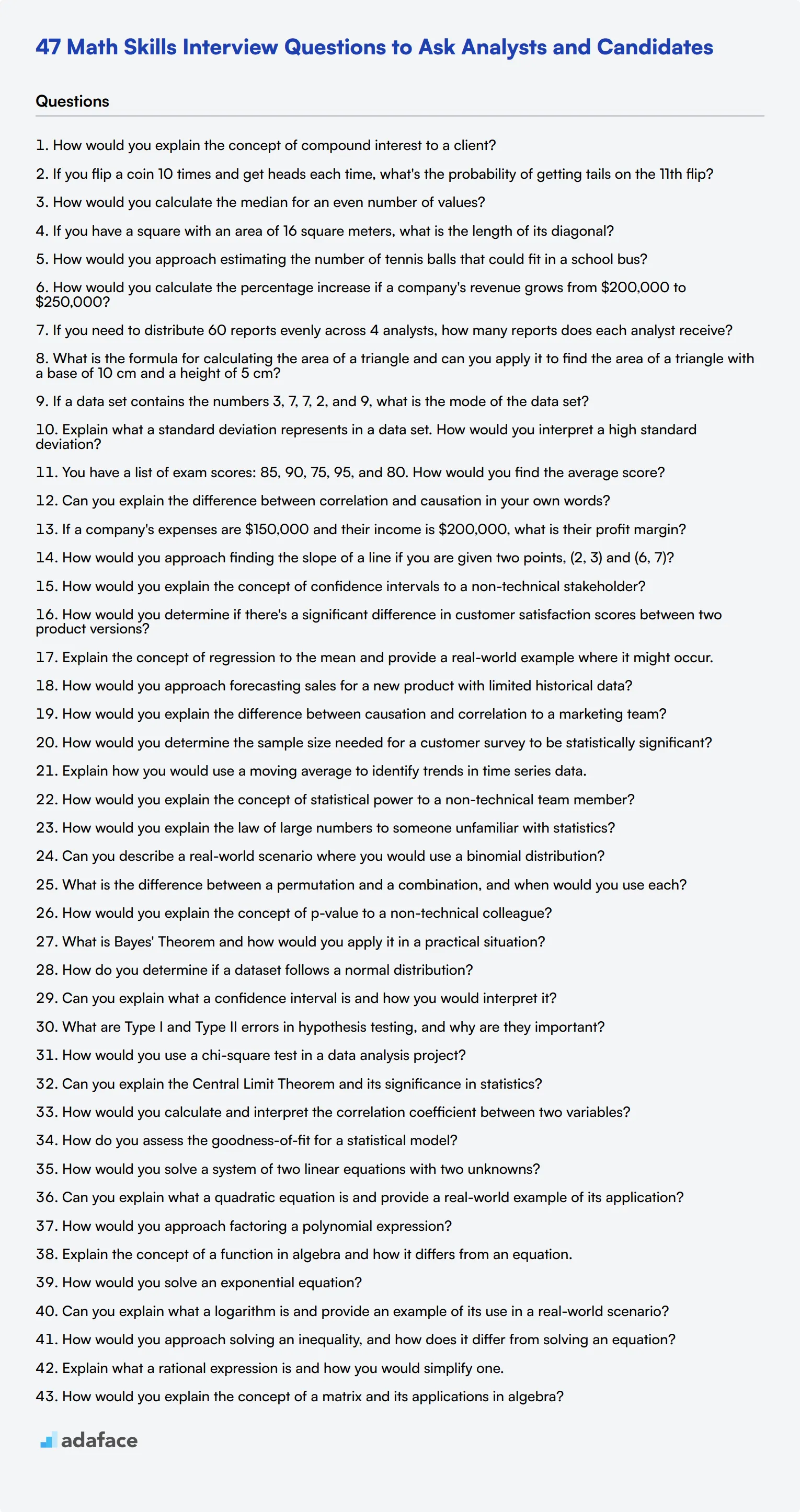When recruiting for roles requiring strong math skills, having a strategic list of interview questions is imperative. These questions help you gauge the candidate's proficiency, analytical capabilities, and problem-solving approach necessary in data-driven roles, such as data analysts.
This blog post provides a compilation of targeted math skills interview questions. It covers various difficulty levels and specific areas, including probability, statistics, and algebra, allowing you to tailor your interview process to different candidate expertise levels.
Using these questions will streamline your hiring process, ensuring you select candidates with robust math skills. For a more comprehensive evaluation, consider leveraging a pre-interview test like our quantitative aptitude test.
Table of contents
Top 6 Math Skills questions to ask in interviews
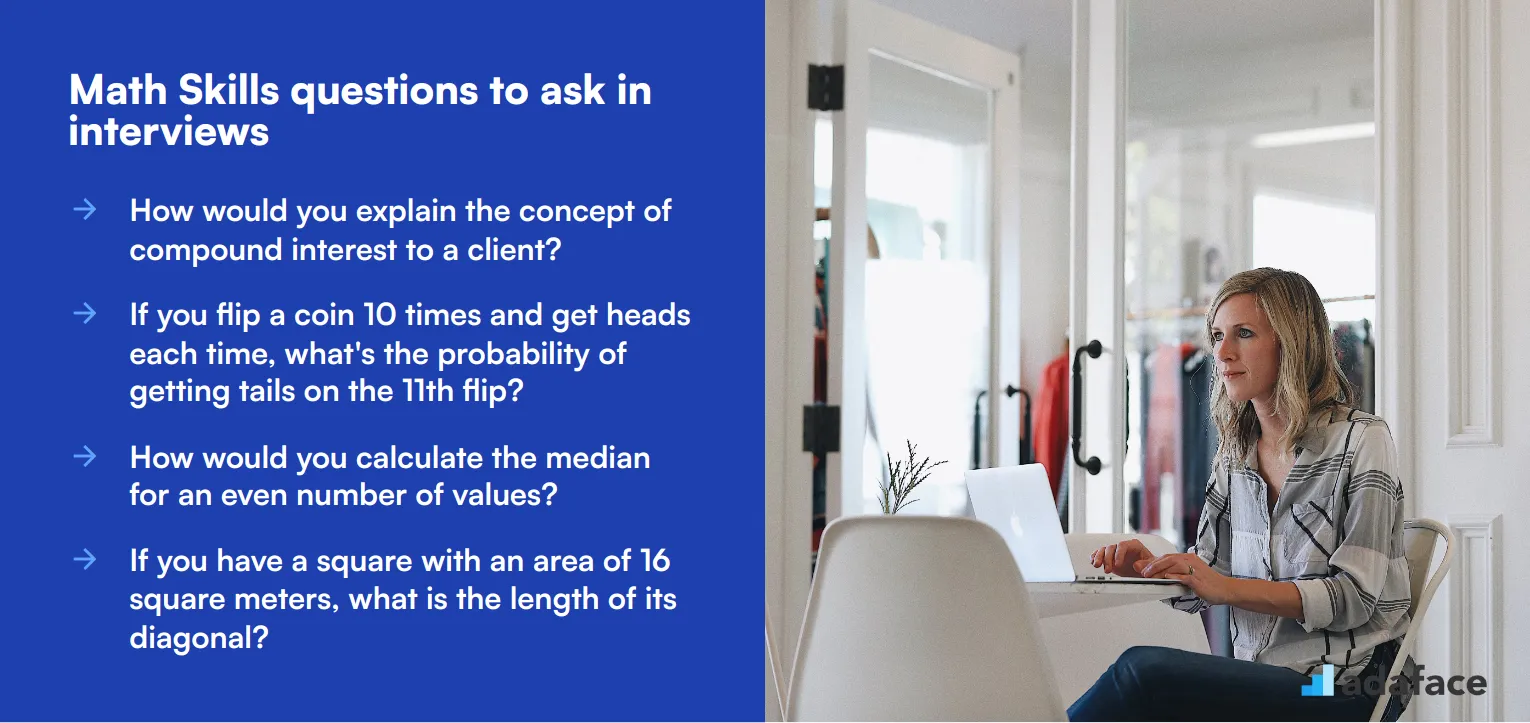
Ready to put your candidates' math skills to the test? These carefully curated questions will help you assess a candidate's numerical prowess and problem-solving abilities. Whether you're hiring for a data analyst or a financial whiz, these questions will give you valuable insights into their mathematical thinking.
1. How would you explain the concept of compound interest to a client?
A strong candidate should be able to explain compound interest in simple terms, such as:
Compound interest is when you earn interest not just on your initial investment, but also on the interest you've already earned. It's like a snowball effect for your money. The longer you leave your money invested, the more it grows, because you're earning interest on top of interest.
Look for candidates who can provide a clear, jargon-free explanation and perhaps offer a simple example to illustrate the concept. Strong answers might also touch on how compound interest differs from simple interest and its importance in long-term financial planning.
2. A project is behind schedule by 25%. By what percentage do you need to increase productivity to complete it on time?
The correct answer is that productivity needs to be increased by 33.33% (or 1/3) to complete the project on time.
Here's the explanation: If the project is 25% behind, it means that 75% of the work has been completed in 100% of the time. To finish the remaining 25% in the remaining 0% of the time, the work rate needs to increase from 75% to 100%, which is an increase of 33.33%.
Look for candidates who not only provide the correct answer but also explain their reasoning clearly. Strong candidates might also discuss how this principle applies to real-world project management and resource allocation scenarios.
3. If you flip a coin 10 times and get heads each time, what's the probability of getting tails on the 11th flip?
The correct answer is 50% or 1/2. Each coin flip is an independent event, and the probability of getting tails is always 50%, regardless of previous outcomes.
This question tests the candidate's understanding of probability and their ability to avoid the 'gambler's fallacy' - the mistaken belief that if something happens more frequently than normal during a given period, it will happen less frequently in the future (or vice versa).
Look for candidates who not only provide the correct answer but also explain the concept of independent events. Strong candidates might also discuss how this principle applies to data analysis and statistical reasoning in real-world scenarios.
4. How would you calculate the median for an even number of values?
To calculate the median for an even number of values:
- Arrange the numbers in ascending order.
- Identify the two middle numbers.
- Calculate the average of these two middle numbers.
Look for candidates who can clearly explain this process and perhaps provide a simple example. Strong candidates might also discuss when using the median is preferable to the mean, such as when dealing with skewed data or outliers.
5. If you have a square with an area of 16 square meters, what is the length of its diagonal?
The correct answer is 5.66 meters (rounded to two decimal places). Here's how to arrive at this answer:
- The area of a square is side length squared. So, if the area is 16 sq m, each side is 4 m.
- The diagonal of a square forms the hypotenuse of a right-angled triangle.
- Using the Pythagorean theorem (a² + b² = c²), we get: 4² + 4² = c²
- 16 + 16 = c²
- 32 = c²
- √32 ≈ 5.66
Look for candidates who can explain their reasoning step-by-step. Strong candidates might also mention the relationship between the side length and diagonal length in a square (diagonal = side * √2) or discuss real-world applications of this principle.
6. How would you approach estimating the number of tennis balls that could fit in a school bus?
This question tests a candidate's ability to break down a complex problem and make reasonable assumptions. A good approach might be:
- Estimate the volume of a school bus (length x width x height).
- Estimate the volume of a tennis ball (4/3 * π * r³).
- Divide the bus volume by the ball volume.
- Apply a packing efficiency factor (e.g., 70%) to account for spaces between balls.
Look for candidates who can articulate their thought process clearly, explain their assumptions, and show comfort with estimation and basic geometry. Strong candidates might also discuss how this type of estimation is useful in various business contexts, such as inventory management or capacity planning.
10 Math Skills interview questions to ask junior analysts
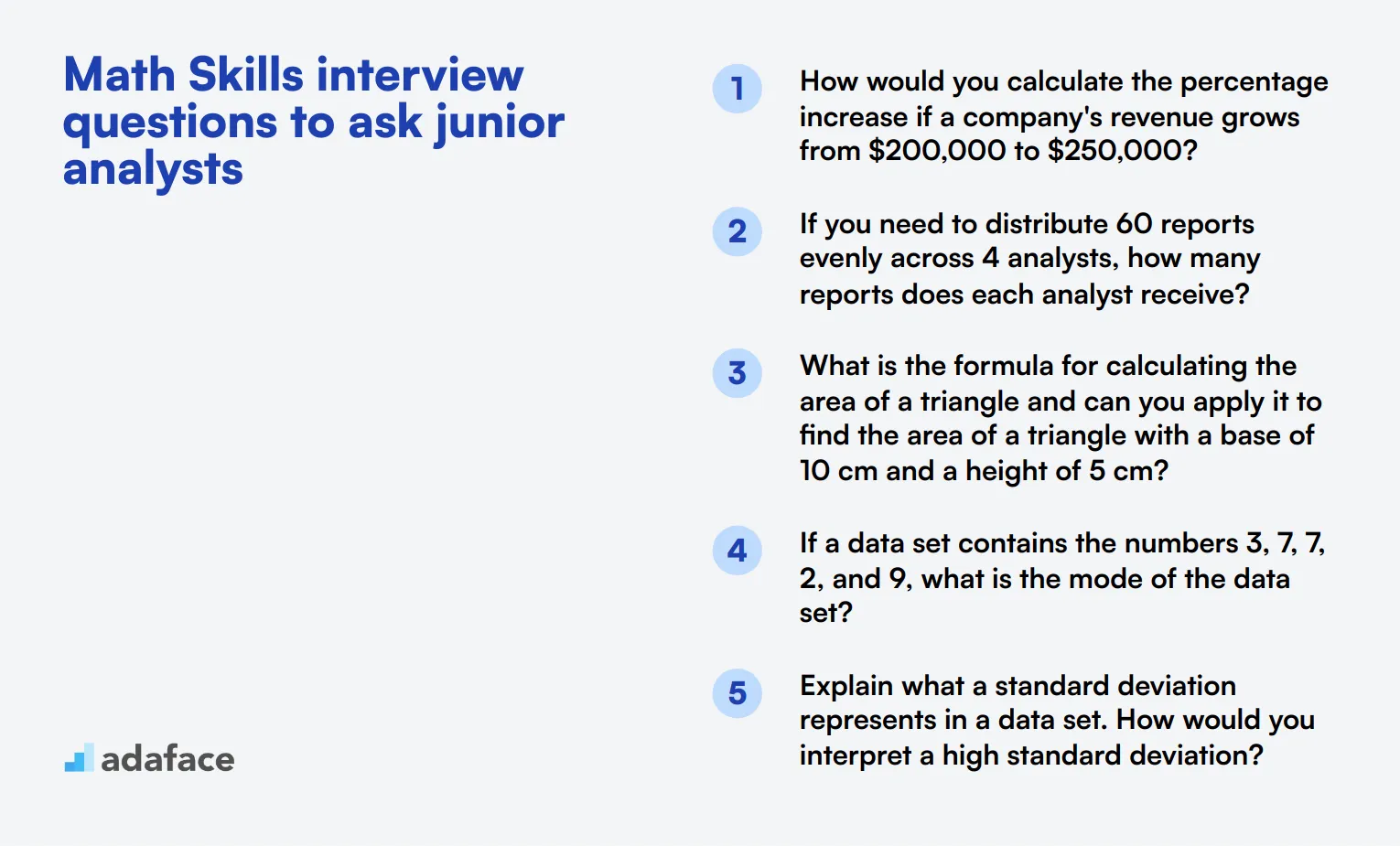
To gauge whether candidates possess essential math skills for a junior analyst role, incorporate these targeted questions into your interview process. They help uncover a candidate's analytical thinking and problem-solving abilities, crucial for effective data analysis in today's data-driven environment. For a comprehensive understanding of the role, consider referring to our Data Analyst Job Description.
- How would you calculate the percentage increase if a company's revenue grows from $200,000 to $250,000?
- If you need to distribute 60 reports evenly across 4 analysts, how many reports does each analyst receive?
- What is the formula for calculating the area of a triangle and can you apply it to find the area of a triangle with a base of 10 cm and a height of 5 cm?
- If a data set contains the numbers 3, 7, 7, 2, and 9, what is the mode of the data set?
- Explain what a standard deviation represents in a data set. How would you interpret a high standard deviation?
- You have a list of exam scores: 85, 90, 75, 95, and 80. How would you find the average score?
- If a store offers a 20% discount on a $50 item, how much will the item cost after the discount?
- Can you explain the difference between correlation and causation in your own words?
- If a company's expenses are $150,000 and their income is $200,000, what is their profit margin?
- How would you approach finding the slope of a line if you are given two points, (2, 3) and (6, 7)?
10 intermediate Math Skills interview questions and answers to ask mid-tier analysts
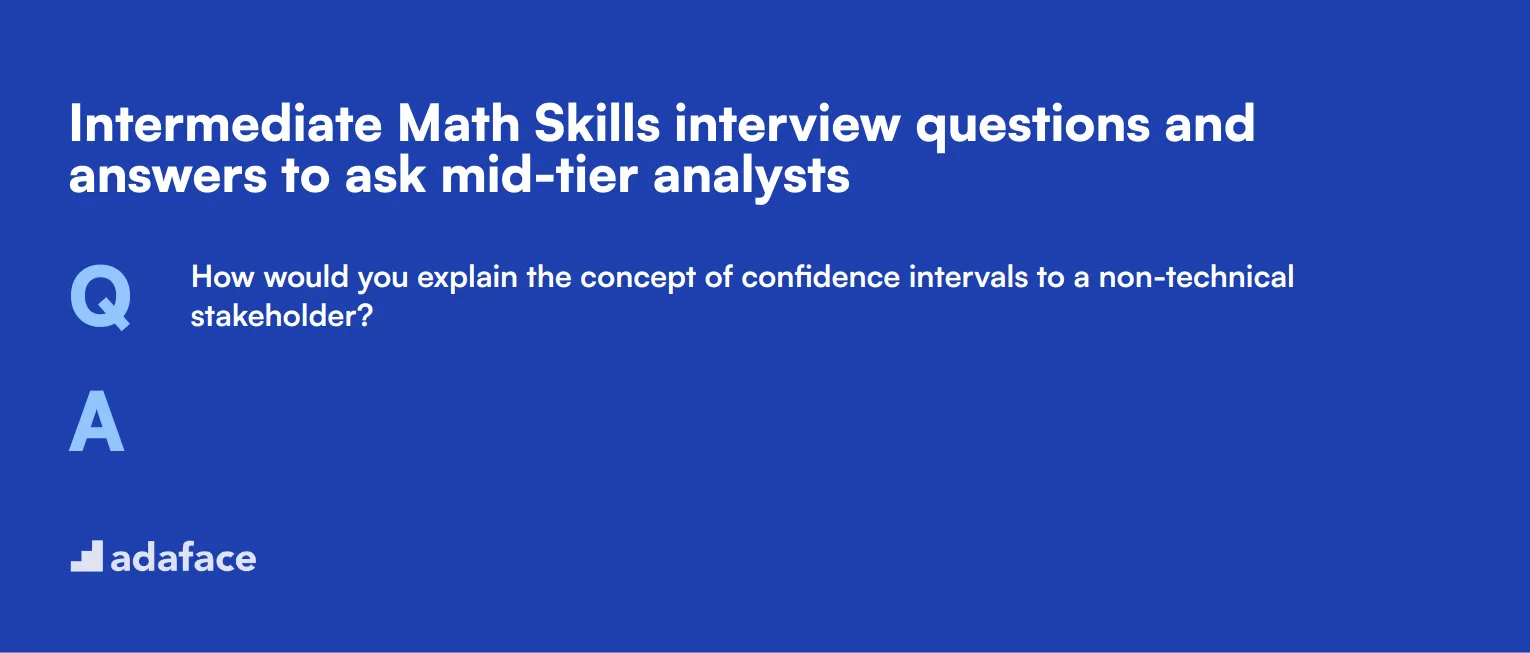
Ready to level up your math skills interviews? These 10 intermediate questions are perfect for assessing mid-tier analysts. They'll help you gauge a candidate's problem-solving abilities and analytical skills without diving into overly technical territory. Use these questions to spark insightful discussions and uncover how candidates approach real-world scenarios.
1. How would you explain the concept of confidence intervals to a non-technical stakeholder?
A strong candidate should be able to simplify the concept of confidence intervals for a non-technical audience. They might explain it as follows:
A confidence interval is like a range of estimates that we're pretty sure contains the true value we're looking for. Imagine you're trying to guess how many jelly beans are in a jar. Instead of giving one exact number, you might say, 'I'm 95% confident there are between 500 and 600 jelly beans.' That range is your confidence interval.
Look for candidates who can use relatable analogies and avoid technical jargon. They should emphasize that confidence intervals provide a measure of uncertainty and reliability in our estimates, which is crucial for making informed business decisions.
2. A company's sales have increased by 5% each month for the past year. If this trend continues, what will be the total percentage increase in sales after two years?
This question tests the candidate's understanding of compound growth. A strong answer would include:
- Recognizing that we need to compound the 5% growth over 24 months
- Using the compound interest formula: (1 + 0.05)^24 - 1
- Calculating the result: approximately 220.9%
- Explaining that the total increase would be about 221% over two years
Look for candidates who not only provide the correct answer but also explain their thought process. They should recognize that simple addition (5% * 24 = 120%) would be incorrect. This demonstrates their grasp of compounding effects, which is crucial in many business analysis scenarios.
3. How would you determine if there's a significant difference in customer satisfaction scores between two product versions?
An ideal response should outline a systematic approach to comparing two sets of data. A strong candidate might suggest the following steps:
- Collect representative samples of satisfaction scores for both product versions
- Calculate basic descriptive statistics (mean, median, standard deviation) for each group
- Conduct a statistical test, such as a t-test or Mann-Whitney U test, depending on the data distribution
- Set a significance level (e.g., 0.05) to determine if the difference is statistically significant
- Interpret the results in the context of practical significance for the business
Look for candidates who emphasize the importance of both statistical significance and practical importance. They should also mention potential limitations of the analysis and the need for sufficient sample sizes. This demonstrates a nuanced understanding of data analysis in real-world scenarios.
4. Explain the concept of regression to the mean and provide a real-world example where it might occur.
Regression to the mean is a statistical phenomenon where extreme observations tend to be followed by more average observations. A good explanation might be:
Imagine a sports team that has an exceptionally good season. The following season, their performance is likely to be closer to their average, even if it's still good. This doesn't mean they've gotten worse; it's just that extreme performances (good or bad) are often followed by more typical ones.
Look for candidates who can provide clear examples and explain why this concept is important in data analysis. They should mention that failing to account for regression to the mean can lead to incorrect conclusions about the effectiveness of interventions or changes. This demonstrates their ability to think critically about data trends and avoid common analytical pitfalls.
5. How would you approach forecasting sales for a new product with limited historical data?
A strong answer should demonstrate creativity and analytical thinking. A good approach might include:
- Analyzing sales data from similar products or product categories
- Conducting market research to gauge potential demand
- Using analogous forecasting methods, comparing to similar product launches
- Incorporating expert opinions from sales and marketing teams
- Developing multiple scenarios (optimistic, pessimistic, most likely)
- Regularly updating the forecast as new data becomes available
Look for candidates who emphasize the importance of combining quantitative and qualitative methods. They should also mention the need for flexibility and continuous refinement of the forecast. This shows their ability to work with limited data and adapt their approach as more information becomes available.
6. How would you explain the difference between causation and correlation to a marketing team?
A strong candidate should be able to clearly distinguish between these concepts using relatable examples. They might explain it as follows:
Correlation means two things tend to happen together, but one doesn't necessarily cause the other. For example, ice cream sales and sunscreen sales might both go up in summer, but eating ice cream doesn't make people buy sunscreen. Causation, on the other hand, means one thing directly causes another. Like how our marketing campaign directly led to an increase in website traffic.
Look for candidates who emphasize the importance of not assuming causation from correlation alone. They should mention the need for controlled experiments or more advanced statistical techniques to establish causation. This demonstrates their ability to think critically about data relationships and avoid misleading conclusions in marketing analyses.
7. If a company's customer churn rate is 5% per month, what percentage of customers will remain after one year?
This question tests the candidate's ability to work with retention rates and compound effects. A strong answer would include:
- Recognizing that we need to calculate the retention rate: 95% (100% - 5% churn)
- Compounding the retention rate over 12 months: 0.95^12
- Calculating the result: approximately 0.54 or 54%
- Explaining that about 54% of customers will remain after one year
Look for candidates who not only provide the correct answer but also explain their reasoning. They should recognize that simply multiplying 5% by 12 months would be incorrect. This demonstrates their understanding of compounding effects in customer retention, which is crucial for accurate forecasting and business planning.
8. How would you determine the sample size needed for a customer survey to be statistically significant?
A strong answer should outline the key factors in determining sample size and the process for calculating it. Key points to cover include:
- Identifying the population size (if known)
- Deciding on the desired confidence level (e.g., 95% or 99%)
- Determining the margin of error you're willing to accept
- Estimating the response distribution (can use 50% if unsure)
- Using a sample size calculator or formula to determine the required sample size
- Adjusting for expected response rate
Look for candidates who understand that larger sample sizes increase accuracy but also cost and time. They should mention the trade-offs between precision and practicality. A good candidate might also discuss strategies for improving response rates to ensure the target sample size is reached.
9. Explain how you would use a moving average to identify trends in time series data.
A strong answer should demonstrate understanding of time series analysis and the purpose of moving averages. Key points to cover include:
- Defining a moving average as the average of a subset of data points over a specific time window
- Explaining that moving averages smooth out short-term fluctuations and highlight longer-term trends
- Describing the process: selecting a time window, calculating averages, and plotting the results
- Discussing the trade-offs of different window sizes (shorter for responsiveness, longer for smoothing)
Look for candidates who can explain how moving averages help in identifying trends by reducing noise in the data. They should also mention limitations, such as lag in detecting changes and the potential for missing short-term patterns. This demonstrates their ability to apply statistical techniques to real-world data analysis challenges.
10. How would you explain the concept of statistical power to a non-technical team member?
A good explanation should simplify the concept without losing its essence. A candidate might explain it as follows:
Statistical power is like the sensitivity of a metal detector. A high-power study is like a sensitive metal detector that's very good at finding metal when it's there. In research, power is our ability to detect an effect if it really exists. The higher the power, the less likely we are to miss important findings.
Look for candidates who can use analogies and avoid technical jargon. They should emphasize that higher power reduces the risk of false negatives (missing real effects) but often requires larger sample sizes or more precise measurements. This demonstrates their ability to communicate complex statistical concepts to non-technical stakeholders, which is crucial in data-driven decision making.
12 Math Skills interview questions about probability and statistics
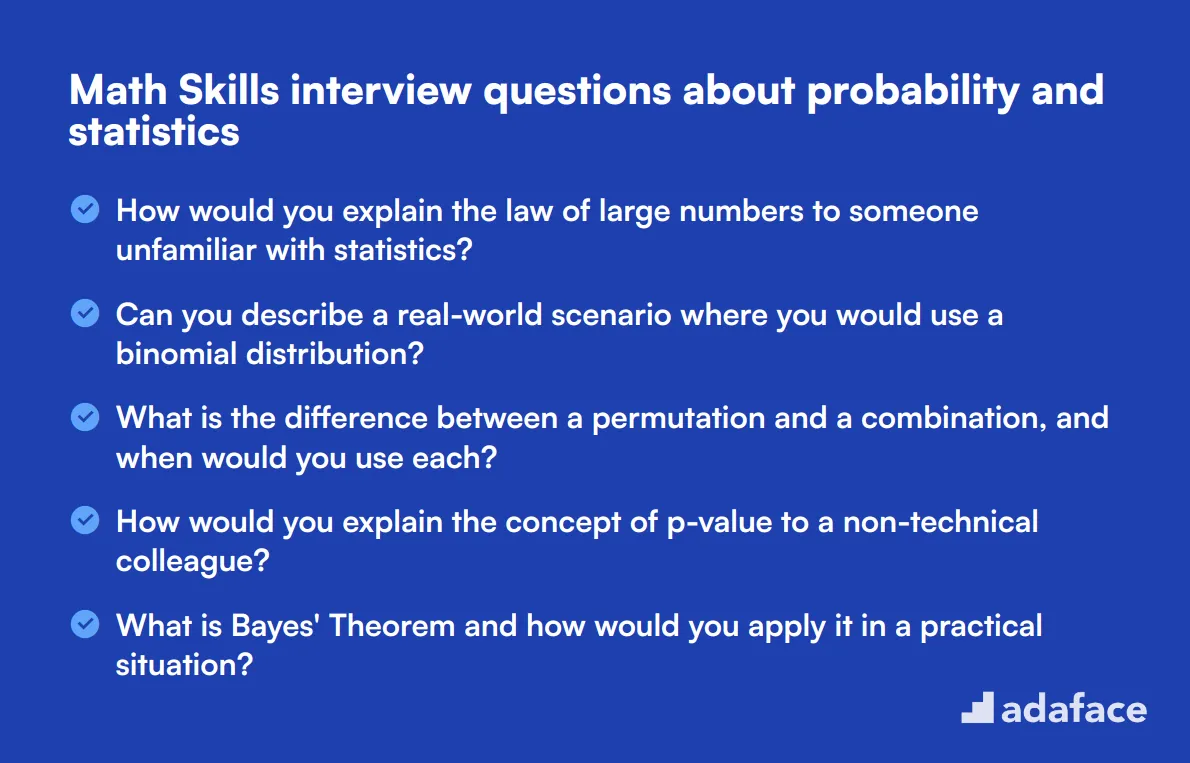
To determine whether your candidates have a solid understanding of probability and statistics, ask them some of these essential interview questions. These questions can help you evaluate their problem-solving abilities and statistical reasoning, which are crucial for roles such as data analyst or data scientist.
- How would you explain the law of large numbers to someone unfamiliar with statistics?
- Can you describe a real-world scenario where you would use a binomial distribution?
- What is the difference between a permutation and a combination, and when would you use each?
- How would you explain the concept of p-value to a non-technical colleague?
- What is Bayes' Theorem and how would you apply it in a practical situation?
- How do you determine if a dataset follows a normal distribution?
- Can you explain what a confidence interval is and how you would interpret it?
- What are Type I and Type II errors in hypothesis testing, and why are they important?
- How would you use a chi-square test in a data analysis project?
- Can you explain the Central Limit Theorem and its significance in statistics?
- How would you calculate and interpret the correlation coefficient between two variables?
- How do you assess the goodness-of-fit for a statistical model?
9 Math Skills interview questions and answers related to algebra

Algebra forms the backbone of many mathematical concepts. These nine interview questions will help you assess candidates' algebraic prowess and problem-solving skills. Use them to gauge how well applicants can apply algebraic thinking to real-world scenarios, a crucial skill for many data-driven roles.
1. How would you solve a system of two linear equations with two unknowns?
To solve a system of two linear equations with two unknowns, I would typically use one of three methods:
- Substitution method: Solve one equation for one variable and substitute it into the other equation.
- Elimination method: Multiply one or both equations by constants to eliminate one variable when the equations are added or subtracted.
- Graphing method: Plot both equations on a coordinate plane and find their intersection point.
Look for candidates who can clearly explain at least one method and demonstrate understanding of the concept. Strong candidates might discuss the pros and cons of each method or when they'd prefer one over the others.
2. Can you explain what a quadratic equation is and provide a real-world example of its application?
A quadratic equation is a second-degree polynomial equation in a single variable, typically written in the form ax² + bx + c = 0, where a ≠ 0. It's characterized by having a squared term as its highest degree term.
A real-world application of quadratic equations is in projectile motion. For example, when launching a rocket or throwing a ball, the path it follows can be described by a quadratic equation. The equation can help determine the maximum height reached, the time it takes to reach that height, and where the object will land.
Strong candidates should be able to provide the standard form of a quadratic equation and at least one practical application. Look for those who can explain how the equation relates to the real-world scenario they've described.
3. How would you approach factoring a polynomial expression?
When factoring a polynomial expression, I would follow these steps:
- Identify the degree of the polynomial and its terms.
- Look for a common factor among all terms and factor it out if present.
- For quadratic expressions, try to identify if it's a perfect square trinomial or the difference of squares.
- If it's a more complex polynomial, consider grouping terms and factoring by parts.
- Always check the factored expression by expanding it to ensure it matches the original polynomial.
Ideal candidates should demonstrate a systematic approach to factoring. Look for those who can explain different factoring techniques and show awareness that not all polynomials can be factored over real numbers.
4. Explain the concept of a function in algebra and how it differs from an equation.
A function in algebra is a relation between a set of inputs (domain) and a set of possible outputs (range), where each input corresponds to exactly one output. It's often represented as f(x) = y, where x is the input and y is the output.
The key difference between a function and an equation is that a function defines a specific relationship where each input has a unique output, while an equation simply states that two expressions are equal. Not all equations represent functions.
Strong candidates should be able to provide examples of functions and non-functions. Look for those who can explain the vertical line test or discuss the concept of one-to-one correspondence in functions.
5. How would you solve an exponential equation?
To solve an exponential equation, I would typically follow these steps:
- Isolate the exponential terms on one side of the equation if possible.
- If both sides have the same base, set the exponents equal to each other.
- If the bases are different, use logarithms to bring down the exponents.
- Solve the resulting equation for the variable.
- Check the solution by substituting it back into the original equation.
Look for candidates who understand the properties of exponents and logarithms. Strong candidates might discuss the limitations of this method (e.g., when dealing with complex numbers) or mention alternative approaches for specific types of exponential equations.
6. Can you explain what a logarithm is and provide an example of its use in a real-world scenario?
A logarithm is the inverse operation to exponentiation. It answers the question: to what power must a given number (the base) be raised to produce another number? For example, log₂(8) = 3 because 2³ = 8.
In the real world, logarithms are often used in scenarios involving exponential growth or decay. For instance, in finance, compound interest calculations often involve logarithms. If you want to know how long it will take for an investment to double at a given interest rate, you can use the rule of 72, which involves logarithms.
Strong candidates should be able to define logarithms clearly and provide at least one practical application. Look for those who can explain the relationship between exponentials and logarithms or discuss properties of logarithms (e.g., log rules).
7. How would you approach solving an inequality, and how does it differ from solving an equation?
Solving an inequality is similar to solving an equation, but with a few key differences:
- We follow many of the same steps as with equations: simplify, isolate the variable, etc.
- When multiplying or dividing by a negative number, we must flip the inequality sign.
- The solution to an inequality is often a range of values rather than a single value.
- We typically represent the solution on a number line or using interval notation.
Look for candidates who understand these key differences. Strong candidates might discuss the concept of boundary points in inequalities or explain how to solve compound inequalities.
8. Explain what a rational expression is and how you would simplify one.
A rational expression is a fraction where both the numerator and denominator are polynomials. To simplify a rational expression, I would follow these steps:
- Factor both the numerator and denominator completely.
- Identify and cancel out any common factors between the numerator and denominator.
- If there are no more common factors, the expression is in its simplest form.
- If the expression is undefined for certain values (where the denominator equals zero), note these restrictions.
Look for candidates who understand that rational expressions are essentially algebraic fractions. Strong candidates might discuss domain restrictions or explain how to perform operations (addition, subtraction, multiplication, division) with rational expressions.
9. How would you explain the concept of a matrix and its applications in algebra?
A matrix is a rectangular array of numbers, symbols, or expressions arranged in rows and columns. In algebra, matrices are used to represent and solve systems of linear equations, transform coordinates in geometry, and model various real-world phenomena.
Matrices have several applications, including:
- Solving systems of linear equations efficiently
- Representing linear transformations in computer graphics
- Analyzing network structures in graph theory
- Organizing and manipulating large datasets in data science
Strong candidates should be able to define a matrix and provide at least one practical application. Look for those who can explain basic matrix operations (addition, multiplication) or discuss concepts like determinants and inverse matrices.
Which Math Skills skills should you evaluate during the interview phase?
Evaluating all aspects of a candidate's mathematical abilities in a single interview is challenging. However, focusing on core math skills can help you gauge their proficiency effectively. Here are some crucial skills to evaluate during the Math Skills interview phase.
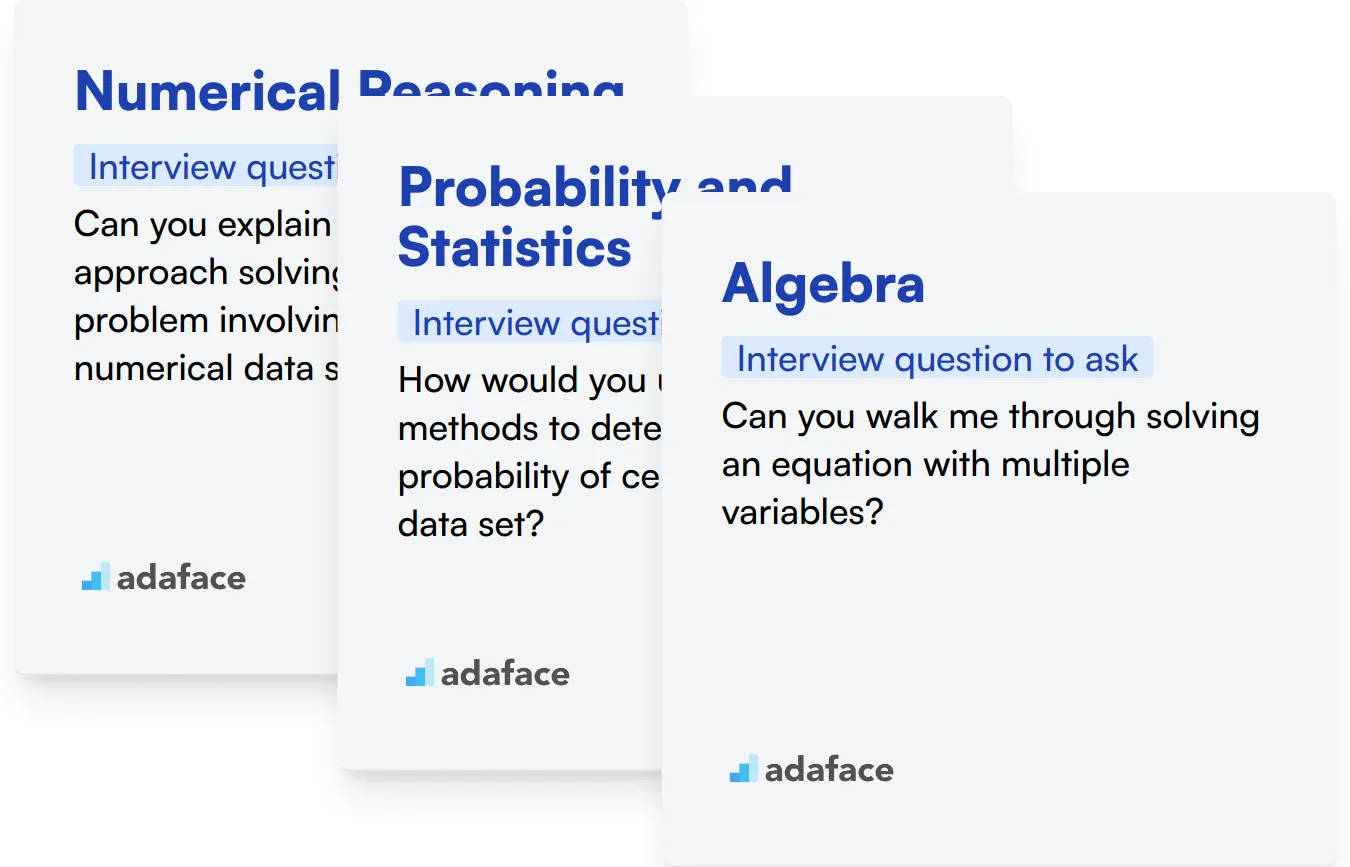
Numerical Reasoning
To filter out candidates with strong numerical reasoning skills, you can use an assessment test that asks relevant MCQs. For example, our Numerical Reasoning Test is designed to evaluate this specific skill.
You can also ask targeted interview questions to assess numerical reasoning abilities during the interview.
Can you explain how you would approach solving a complex problem involving multiple numerical data sets?
Look for a structured approach in the candidate's response. They should demonstrate their ability to break down the problem, identify key numerical elements, and apply logical steps to reach a solution.
Probability and Statistics
To assess this skill, you can use our Probability Test which includes questions specifically designed to evaluate knowledge in probability and statistics.
Another way to gauge this skill is by asking interview questions that focus on real-world applications of probability and statistics.
How would you use statistical methods to determine the probability of certain events in a data set?
Listen for an explanation that includes identifying variables, selecting appropriate statistical methods, and interpreting the results. The candidate's ability to translate statistical concepts into practical applications is key.
Algebra
To assess algebraic skills during the interview, consider asking specific questions that test their knowledge and application of algebraic principles.
Can you walk me through solving an equation with multiple variables?
Focus on whether the candidate can clearly explain their thought process and method for isolating and solving variables. Look for accuracy and logical consistency in their approach.
Maximizing the Effectiveness of Math Skills Interview Questions
Before putting your newfound knowledge into practice, consider these tips to enhance your math skills assessment process. These strategies will help you make the most of your interviews and candidate evaluations.
1. Implement Pre-Interview Skills Tests
Begin your assessment process with targeted math skills tests. These tests provide an objective baseline for candidate abilities before the interview stage.
Consider using a numerical reasoning test to evaluate basic math proficiency. For more advanced roles, a quantitative aptitude test can assess higher-level mathematical thinking.
By using these tests, you can shortlist candidates more effectively and tailor your interview questions to each candidate's demonstrated skill level. This approach saves time and ensures a more productive interview process.
2. Curate a Balanced Set of Interview Questions
With limited interview time, it's crucial to select a mix of questions that cover key math skills relevant to the role. Aim for a balance between basic concepts and more complex problem-solving scenarios.
Include questions that assess related skills such as logical reasoning or data interpretation. These complementary areas can provide a more rounded view of a candidate's analytical abilities.
Consider incorporating behavioral questions to understand how candidates apply their math skills in real-world situations. This combination will give you a comprehensive picture of their capabilities.
3. Master the Art of Follow-Up Questions
Asking thoughtful follow-up questions is key to uncovering a candidate's true depth of knowledge. It helps distinguish between memorized answers and genuine understanding.
For example, after asking a probability question, follow up with 'How would you explain this concept to a non-technical team member?' This tests both their math skills and their ability to communicate complex ideas clearly.
Use Math Skills interview questions and skills tests to hire talented analysts
If you are looking to hire someone with strong math skills, it’s important to ensure they have these skills accurately. The best way to do this is to use skills tests such as our Quantitative Aptitude Test or Numerical Reasoning Test.
Once you've used a test to shortlist the best applicants, you can call them for interviews. For the next steps, you can sign up here or explore our full test library.
Data Interpretation Assessment Test
Download Math Skills interview questions template in multiple formats
Math Skills Interview Questions FAQs
Math Skills are key for analysts as they enable data interpretation, statistical analysis, and problem-solving, which are core components of the role.
You can assess Math Skills by asking theoretical questions, presenting practical problems, and observing the candidate's approach to solving them.
Focus on probability, statistics, algebra, and general problem-solving skills, as these are commonly used in analytical roles.
Adjust the complexity of questions based on the candidate's experience. Use simpler questions for juniors and more advanced ones for experienced analysts.
Yes, combining interview questions with skills tests can provide a more comprehensive evaluation of a candidate's mathematical abilities.

40 min skill tests.
No trick questions.
Accurate shortlisting.
We make it easy for you to find the best candidates in your pipeline with a 40 min skills test.
Try for freeRelated posts
Free resources




